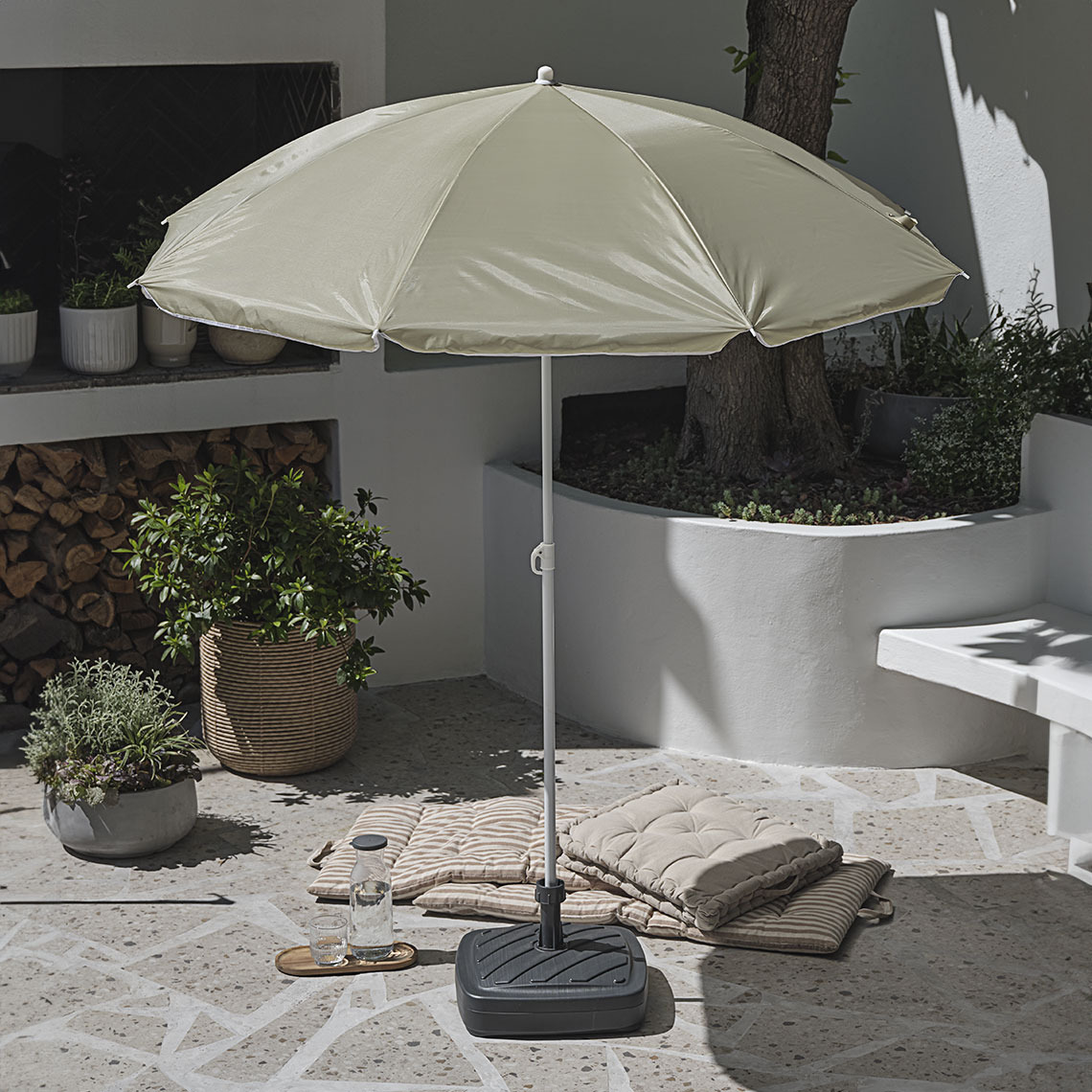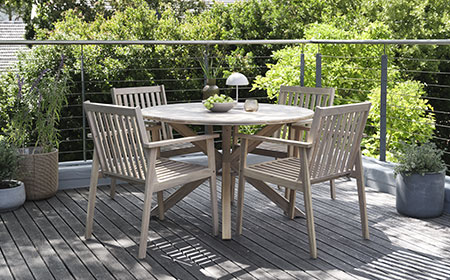Summer is a joyous time of year that is perfect for enjoying and spending more time outdoors. Despite the outdoor season being an exciting time that many of us love, we all know those hot summer days where seeking shelter in the shade is a number one priority.
Whether you are looking for decorative shade for a green garden oasis or a sunlit apartment balcony, getting a parasol or a garden umbrella is an obvious choice. Before deciding which parasol to go for, there are several factors you should consider – these include shapes, sizes, materials, style, and other features. These are outlined in this guide, so read on to be fully empowered to make the right choice of a garden umbrella or parasol from the get-go.
What do you use a garden parasol for?
The main use of a garden parasol is its practicality. Garden parasols, consisting of a canopy made from durable fabric and supported by a sturdy wooden or metallic frame, serve as versatile outdoor accessories. Not only do they offer functional benefits, but they also enhance the aesthetic appeal of outdoor spaces, serving as decorative elements that add charm and character.
The primary function of a garden parasol is to provide essential shelter from the sun. During warm summer days, when the sun's rays are intense, a parasol offers a cool retreat, allowing you to enjoy the outdoors comfortably. Additionally, when unexpected rain showers occur, a garden parasol also provides reliable shelter from rainfall, ensuring that you will avoid getting soaked so outdoor gatherings can continue without interruption.
Overall, the practicality of garden parasols makes them indispensable outdoor accessories, offering a combination of functionality, aesthetic appeal, and weather protection to enhance your garden, patio, balcony, or any other type of outdoor space.
1. How do you choose the right garden parasol?
Choosing the right parasol for your outdoor space, whether it is a garden patio or a balcony, can be a difficult decision to make – how can you be sure what to base your decision on? When it comes to selecting a parasol, the main considerations include your available space on other relevant aspects in your outdoor area, including other furniture, and the type of parasol that best suits your specific needs.
Additionally, aspects such as size, shape, materials, style, and colours will also affect your final decision, and considering all of these will allow you to decide on a parasol that complements your outdoor space and personal taste while providing the benefits you are looking for. Learn more about choosing the perfect parasol in this guide.



Between smaller options such as the HEJLPLET parasol, perfect for balconies and outdoor areas where space is a premium, classic and medium-sized ones like LAMMEHAVE, and the largest options such as KARRYD that can shade a large garden table or seating area, the right parasol for you is just waiting to be found.
What to look for in a garden parasol
What should you consider before purchasing a garden parasol? To ensure that your new garden parasol suits your space and provides the benefits that you are looking for, there are several things you may want to look into, including:
- Canopy size and shape options: Round or square
- Frame and pole materials: Aluminium, steel, or wood
- Features: Freestanding, tilting, or overhanging
- Fixation options: Different parasol bases
- Considerations for UV protection, water resistance, and wind resistance
2. Parasol size and your outdoor space
Parasols come in a variety of sizes – from small, portable free-standing parasols that you can bring to the beach to large hanging parasols ideal for providing shade over expansive outdoor dining or lounge areas, there is a perfect fit for any purpose and outdoor space. When talking about the size of a parasol, it is generally understood to refer to the width or diameter of the canopy rather than the height of the pole.
A rule of thumb to keep in mind when determining the appropriate size of a parasol is that it should extend at least a little further – around 50 cm – over each side of the area to where it provides shade. For instance, if you have a round D110 cm garden table, aim for a parasol that is at least D210 cm in size. This ensures proper shade and shelter for those seated around the table. Keep in mind that this is a rough guideline, not a set-in-stone rule – you are of course free to choose whatever size that you think best suits your space.
Choosing a parasol in a size that suits the size of your outdoor space is also essential to end up with a proper solution. Even if the guideline mentioned above suggests are large parasol to cover a particular area, it might end up being too large for your space, taking up too much valuable space or overshadowing the entire area unintentionally.
In other words, to achieve the best match possible, you should consider both the size of the parasol in relation to the furniture you want shade for, as well as its size relative to the overall size of your outdoor space.


3. The types of garden parasols
There are several different types of garden parasols to choose from. From straight, classic parasols to large hanging ones with tilt and adjustment functions, you can be sure to find one that suits your needs perfectly.
A classic upright parasol is an excellent option for a small patio or balcony. This type of parasol typically features a straight pole made from metal or wood, and it comes in various colours and sizes. If your garden table has a hole in the centre, it is likely designed for anchoring an upright parasol to provide shade for those seated at the table. Many upright parasols also offer adjustable pole heights.
If your garden table does not have a hole in its centre, a parasol with a tilting function is a good choice. Even though the parasol will not be centred above the table, the tilt feature allows you to control the shade it provides. This feature also enables you to adjust the parasol throughout the day to ensure continuous shade as the sun moves across the sky.
For very small patios or balconies, or if you prefer to maximize your available and perhaps limited space, a balcony parasol is ideal. It can be placed directly against the wall, so it does not unnecessarily take up useful space.
A hanging parasol is an excellent option for large patios. While it does occupy space, it can provide shade for a sizable area. Positioned beside a garden table, it offers overhead shade with no issue. With the ability to tilt and rotate, and if equipped with wheels on its base, it can be easily manoeuvred despite its larger size.
4. Parasol shapes
When deciding on a garden parasol, the two main shapes are square and round. Square parasols offer a modern aesthetic and efficient use of space, ideal for compact areas. They provide ample shade coverage, especially for square or rectangular dining tables and are thus perfect for gatherings. On the other hand, round parasols generally evoke a classic charm and offer a traditional look. Their design facilitates easy rotation, ensuring optimal shade throughout the day.
5. Parasol materials and their properties
Garden parasols come in various materials, each with distinct properties. A common material for the canopy is polyester, and parasols made with this material offer low maintenance and durability – some polyester canopies even feature UV resistance and/or are waterproof. For the parasol pole, wooden poles evoke a traditional aesthetic while metal ones ensure durability and are generally more flexible.
Consider the benefits of each material as well as its visual impact on your outdoor area – choose based on your preferences and the specific requirements of your outdoor space. Make sure to check out the product specifications for a parasol that you find interesting to gain a full overview of its benefits. To learn more about the different materials used for outdoor furniture and accessories, check out our comprehensive guide to garden furniture materials.
6. Aesthetic and style
When selecting a garden parasol, consider your aesthetic preferences. Various parasols offer different options such as colours like beige, off-white, or different shades of grey, along with decorative features such as tassels, stripes, seams, and fringes. It is naturally completely up to you to choose a style that complements your outdoor decor while still prioritising functionality in relation to the needs that you want your garden parasol to meet.
7. Garden parasol accessories: Parasol bases and covers
When selecting a parasol, the choice of base is crucial. It should be sufficiently heavy to provide stability, especially for larger parasols with wide canopies that are susceptible to toppling due to wind uplift. There is no hard rule about how heavy a base must be in relation to the size of the garden parasol. However, generally the heavier the better.
There are different sizes of parasol bases and different weights. Aim for a balance between getting one that is not too large and disruptive for your space while ensuring that it is heavy enough to keep the parasol safely anchored at all times.
In our assortment, you will find parasol bases made from granite and plastic. Functionally, each type does the job of securing the parasol, but visually they can differ – this may affect the overall aesthetic of the parasol in your space, so consider if you prefer the looks of one over the other.
You should also consider if you want a parasol cover to protect your garden umbrella. If you are unable to stow away your parasol in a garage or shed when not in use, a parasol cover can be a great solution to keep it safe from the elements.
Shade sail: An alternative to a parasol
For those seeking a permanently shaded spot to escape the sun, a sunshade or shade sail is an excellent alternative to a parasol. Its fixed position means you do not have to worry about bringing it out or moving it around, and it ensures consistent shade throughout the day without taking up space at ground level. By securing one side to, for instance, a house wall and the other to a nearby pole or tree, shade sails provide stable and reliable shade. Different options exist, with some featuring a single attachment point and others offering dual attachment points for added flexibility.

See our full garden parasol assortment
You will find a wide range of parasols and garden umbrellas in our assortment. Check out the selected ones below or our full assortment in our online store.










